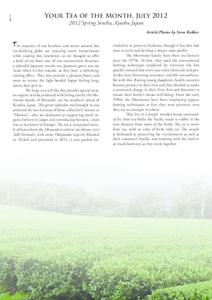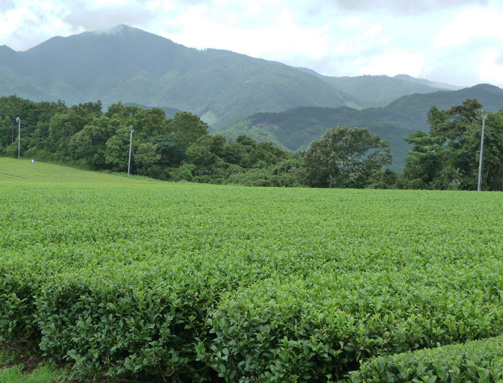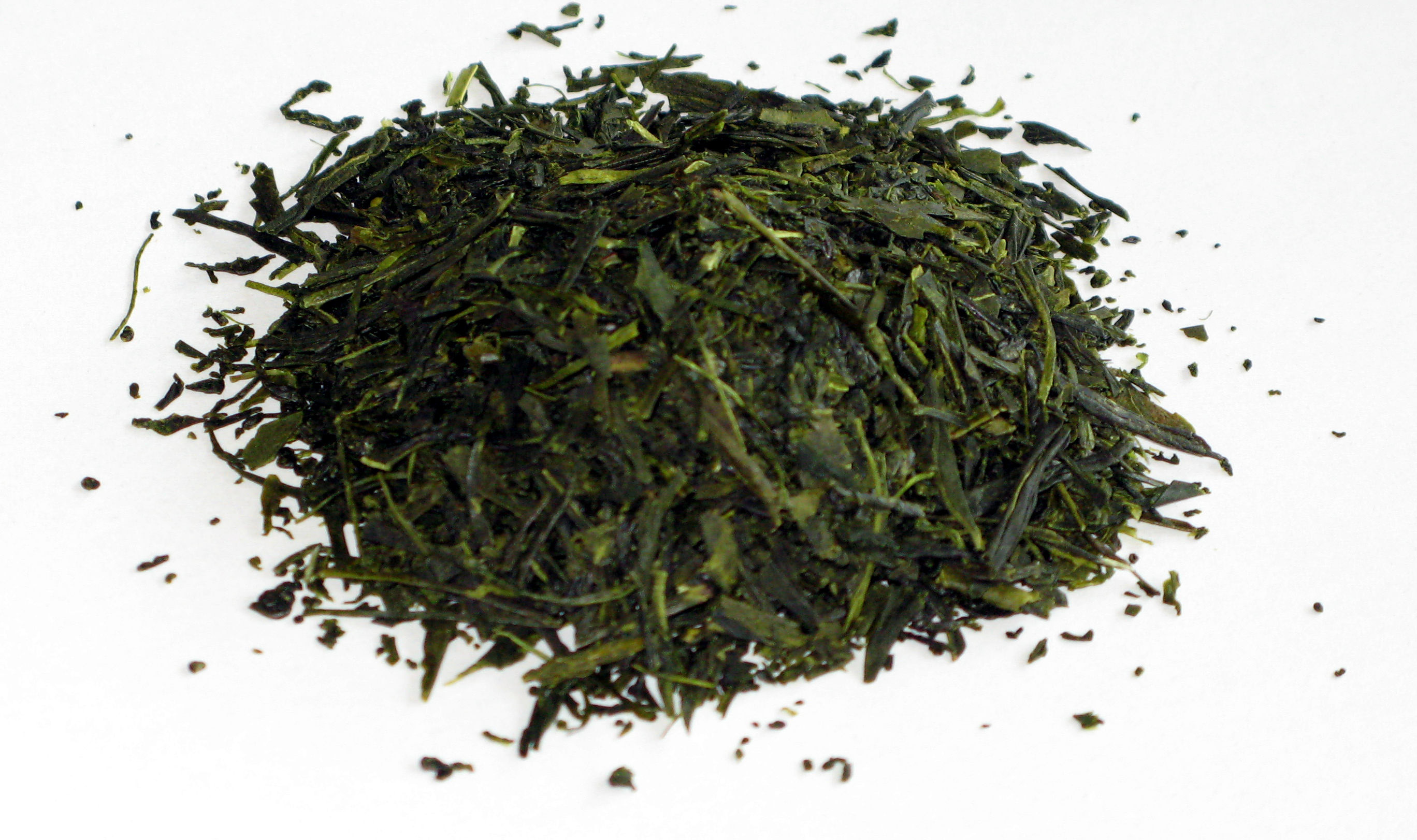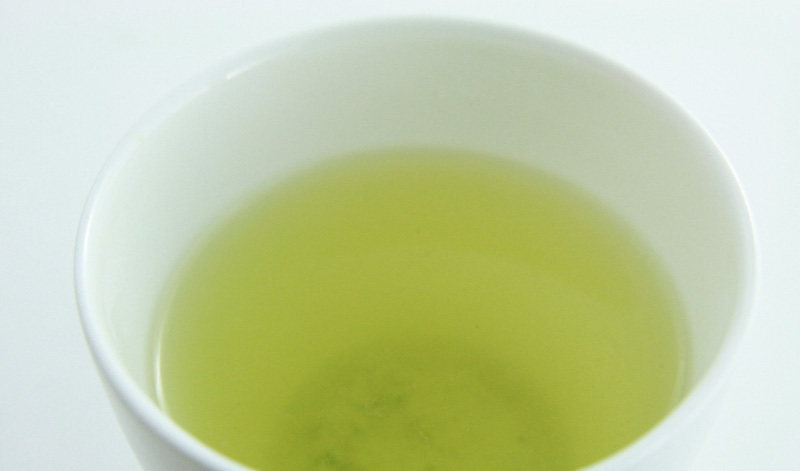
 |
|
The majority of our brothers and sisters around this tea-drinking globe are enjoying warm temperatures while reading this newsletter, so we thought to offer a kind of tea that's one of our summertime favorites: a splendid Japanese sencha tea. Japanese green teas are treats when it's hot outside, as they have a refreshing, cooling effect. They also provide a pleasant boost and seem to mirror the light-headed happy feeling long, sunny days give us.

We hope you will like this month's special. treat, an organic sencha produced with loving care by the Morimoto family of Miyazaki, on the southern island of Kyushu, Japan. This green splendor was brought to our attention by two German fellows collectively known as "Marimo", who are dedicated to supporting small organic farmers in Japan and introducing fantastic, clean teas to tea-lovers in Europe. The tea is comprised mainly of leaves from the Okumidori cultivar (see below: Let's Talk Varietals), with some Okuyutaka expertly blended in. Picked and processed in 2011, it was packed immediately to preserve freshness, though it has also had time to settle and develop a deeper taste-profile.

The Morimoto family have been tea farmers since the 1970s. At first, they used the conventional farming techniques employed by everyone else but quickly noticed that every year extra chemicals and pesticides were becoming necessary, and felt uncomfortable with this. Raising young daughters, health concerns became primary in their lives and they decided to make a concerted change in their lives, first and foremost to ensure their family's future well-being. From the early 1980s, the Morimotos have been employing organic farming techniques; at first they were pioneers, now they are an example to others.
They live in a simple wooden house surrounded by their tea fields; the Pacific ocean is visible in the near distance from some of the fields. The air is sweet from tea, with an echo of fresh, salty air. The couple is dedicated to preserving the environment as well as their customer's health, and working with the land in as much harmony as they work together.

This Okumidori is processed in a similar way to most other Japanese sencha teas. Freshly plucked leaves are brought down from the fields to the processing farm as quickly as possible and go through the kill-green stage (with no withering) to preserve color, freshness and a lightly bitter 'bite'. This enzymatic deactivation is done primarily by steaming in Japan (see below: What's Your Mushi?). Ironically, the word 'sencha' literally means 'roasted tea' but this refers historically to older methods of processing Japanese leaf tea, versus the ground, or 'mo', tea (matcha), which had been part of Japanese culture for centuries before steeping leaf tea became popular in the 17th century. The processing of sencha (see below: One Category, Many Differences) was developed in the 18th century. By steeping leaves, tea was brought into the houses of the common folk and could finally be an everyday experience, or at least not a luxury to be experienced rarely in formal ceremonies or almost exclusively by the ruling classes.
Your July Okumidori is a blend of two cultivars (see below: Let's Talk Varietals) - chiefly Okumidori (itself a blend of second and third harvests, that is harvests from both June and August), as well as some third harvest Okuyutaka. These leaves are evidently flat and on the large, thick side - one way to spot that they are not spring plucks (which would be more tender and small). The tea is Asamushi, which you can tell from the general scarcity of small, broken bits, with the second harvest teas having received a slightly longer steaming than the third harvest teas. This is because the second harvest leaves are slightly thicker than third harvest ones as the Morimotos cut back the tea bushes slightly after the second harvest to ensure relatively tender shoots during a third harvest. This makes their method of farming not completely wild (which would allow the tea bushes to grow as they like and be plucked when ready) but in the Japanese context, their method of farming is considered noninvasive.
For those worried about possible radioactivity from the March 2011 Fukushima nuclear disaster, Marimo has each of their teas specially tested for radionucleides, and the reports are available online. There was not a trace of radioactive material in tests done both in Japan and Europe. The team is so thoroughly dedicated to offering organic teas to people, they as a matter of responsibility do all they can to ensure their teas' complete safety.

This Okumidori is not quite as fragile as some other Japanese green teas, where the difference of just a few degrees in water temperature or a difference of a few seconds can make the difference between paradise and mouth-puckering intensity. Still, we recommend relatively cooled (ideally spring) water (70-75C), with a proportion of 4-6g (a heaping teaspoon) per 225-250ml of water. Steepings can be 45-60s for the first, 3045s for the second, over a minute for the third. With this and other teas, do experiment with brewing times and water temperatures. For example, many Japanese teas are delightful when steeped in cold water, with a slightly higher leaf per water ratio and left to steep for 10-12 minutes. You'll never need to buy commercial iced tea again!

A little look at Japanese tea cultivars would be instructive at this point. As domestic consumption of tea started to soar in the 1970s, Japanese tea farmers looked for a way to reduce dependency on importing tea from elsewhere and increase domestic production. The Yabukita varietal at this point became king and even today, some 75% of all teas produced in Japan are made from Yabukita leaves. This particular strain offered a pungent and pleasant umami taste profile and proved high-yielding and relatively easy to cultivate. Eventually, however, having such a one-variety dominance led to immunity problems and Yabukita became susceptible to pests and diseases which in turn required a large amount of fertilizers and pesticides to be used. Other varieties were then developed, and today there are over 50 official cultivars classified in Japan, though the real number may be infinite - only Nature truly knows.

Yabukita, which was developed from an indigenous wild variety of camellia sinensis growing in Shizuoka, still dominates production, but let's look at a few other varietals currently being farmed in Japan:
A distant second to Yabukita in terms of volume of production, and mainly grown in Japan's southern Kagoshima and Miyazaki regions.
Noted for its mild, slightly smoky notes, this tea was developed in the early 1970s as a cross between Yabukita and another Shizuoka variety. This variety is often used in gyokuro and matcha processing, along with the equally revered Samidori varietal.
This is one of the newer varietals in Japan but quickly gaining popularity for its sweet aroma and deep, rich notes. It is also used in matcha production.
The kill-green (shaqing) process (to kill enzymes in the leaf which would otherwise lead to oxidation) in Japan is almost always done by steaming (versus by frying, as is the common rule in China). "Mushi" means steamed. Just how long the leaves are steamed, however, can affect the resulting green tea massively. In addition to knowing when your Japanese tea was picked, from which region, and whether or not it was shaded, you also want to know the tea's mushi-ness.
As with all categorizations, this one is also illusory in that teas rarely sit neatly in one category or the other. Think of this as a continuum rather than as strict categories. Also, the definitions of these categories has changed somewhat over the years as teas in general are being steamed for longer than they were traditionally. This has to do with the changing palate of consumers but also because extremely short steaming produces teas best drunk after having 'sat' for several months; the modern market demands more ready to drink teas. That's why most current Japanese teas don't age as well as they used to and are best drunk within a year or so of production (with notable exceptions).
This is the most common form of steaming, and the resulting leaves tend to be longer, intact, with fewer small bits of leaf visible. The liquor is quite clear, often a transparent green-yellow, and the taste is lighter than that produced by other steaming methods; many people like this as it tends to preserve the leaf 's fresh, vegetal taste. Almost all shincha (early Spring pluckings) are Asamushi to emphasize their gentle nature. The taste is refined, elegant, crisp and clear.
Those stepping into the Japanese green tea world tend to go wild over Fukamushi (deep steamed) teas. These teas are often quite intense in taste, but very sweet as well; umami and bitterness are backgrounded to a very full-bodied experience, which appeals to those who haven't developed a palate for Japanese teas yet. These teas are not subtle (as evidenced by the cloudy, thick appearance of the liquor) and not known for delicacy, but quite often the first two steepings can be intensely delicious mouthfuls. Their appearance is easy to spot: lots of small leaf pieces, as if they've been finely chopped. The wet leaves clump together in a paste-like glop that's fun to mix with soya sauce after steeping and eat up! Legend has it that the deep steaming process was developed about thirty years ago to compensate for declining water (or tea leaf ) quality - the more intense taste masked any other present defects. Low-grown teas (versus high mountain grown) are better suited to becoming Fukamushi.
Not much to say here, as these 'mediumsteamed' are predictably in-between the other two extremes, exhibiting characteristics of both. It is sometimes hard to visually discern a Chumushi from some Asamushi teas.
We talk about shorter and longer steepings, but how long is long? It's hard to give a precise definition as the length of steaming depends on the leaf and climatic conditions, but very generally, Asamushi usually means a steaming of up to 30 seconds, Chumushi around 45 seconds and Fukamushi up to 90 seconds. Some teas are given up to 2 minutes of steaming, and some rare teas go through a two-step steaming. The difference might not seem long to us, but these few seconds make all the difference to your drinking experience!
Although Japan produces almost only green tea, the difference between the kinds of green tea processed can be staggering. Here's a very brief introduction to some of the different kinds of green teas you may find in Japan: There are four main categories of Japanese green tea: bancha (late-harvest, or common tea), sencha, gyokuro and matcha. Sencha accounts for over 80% of all tea produced in Japan, bancha about 10%, matcha about 1% and gyokuro, which can be among the world's most expensive teas, about 0.3%. Both matcha and gyokuro are made with so-called shaded leaves - entire plantations and tea gardens are shaded from the sun from a few days to several weeks before harvesting. This causes numerous changes in the leaf, which increase umami, sweetness and intensity. Other kinds of teas include: